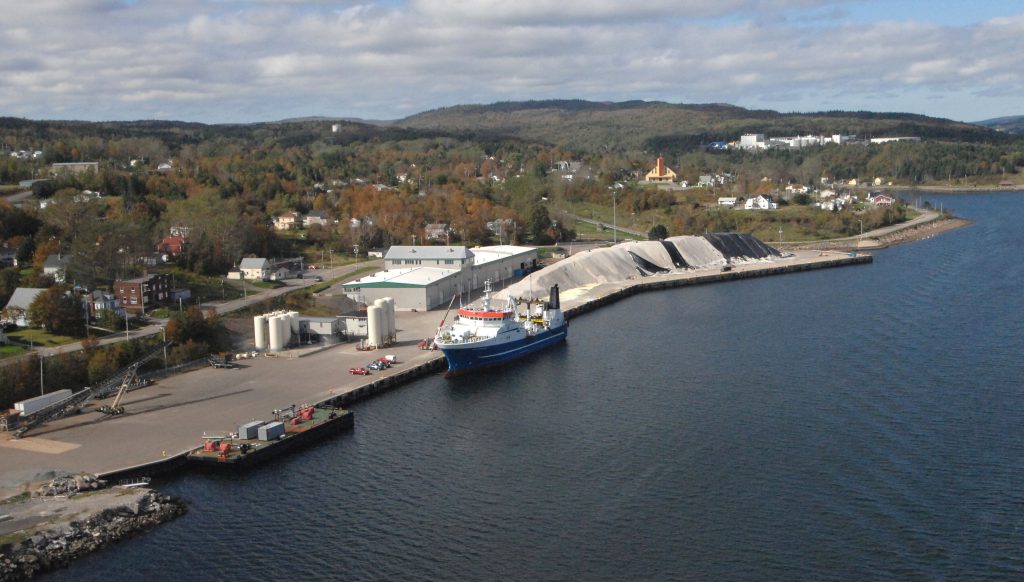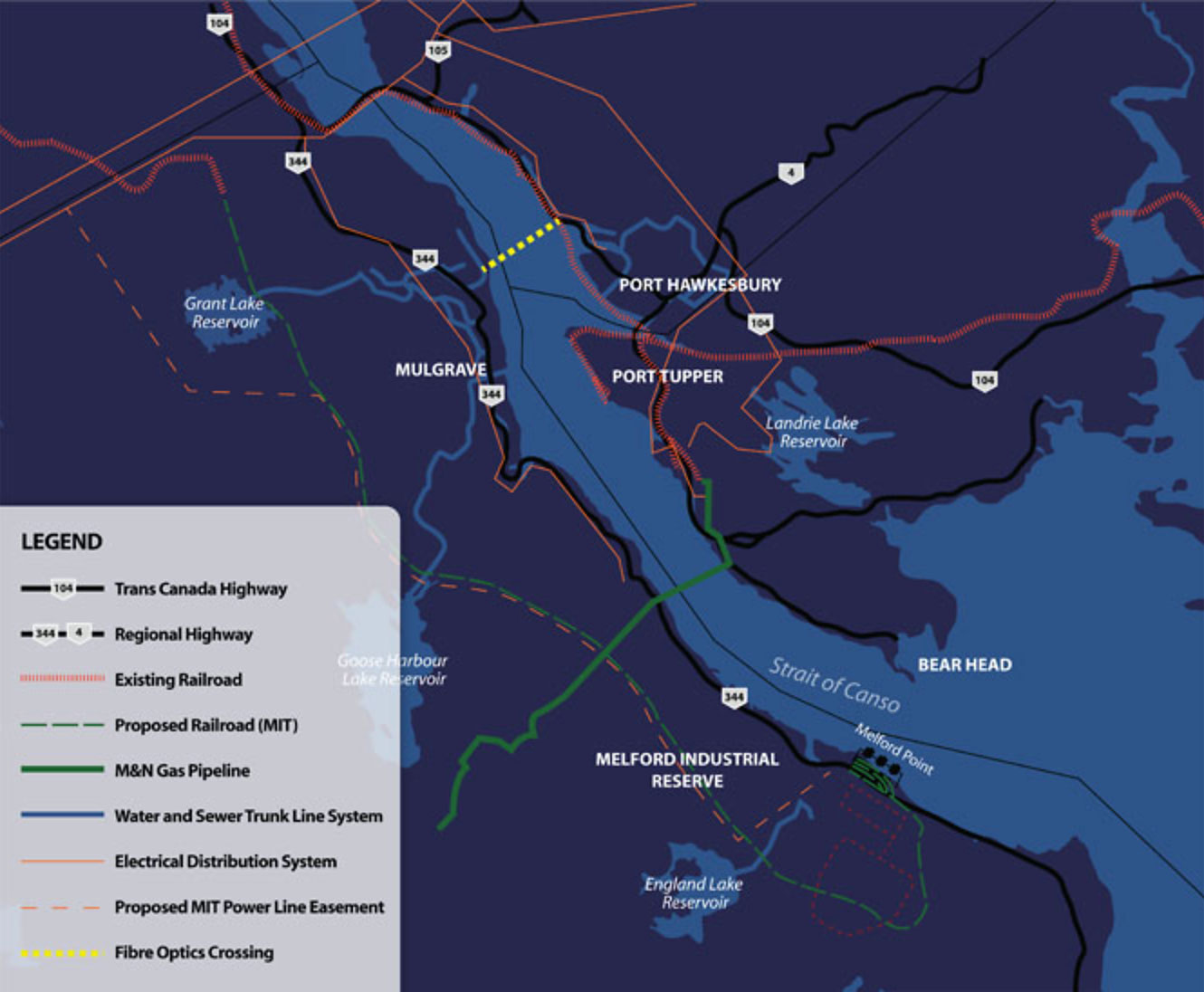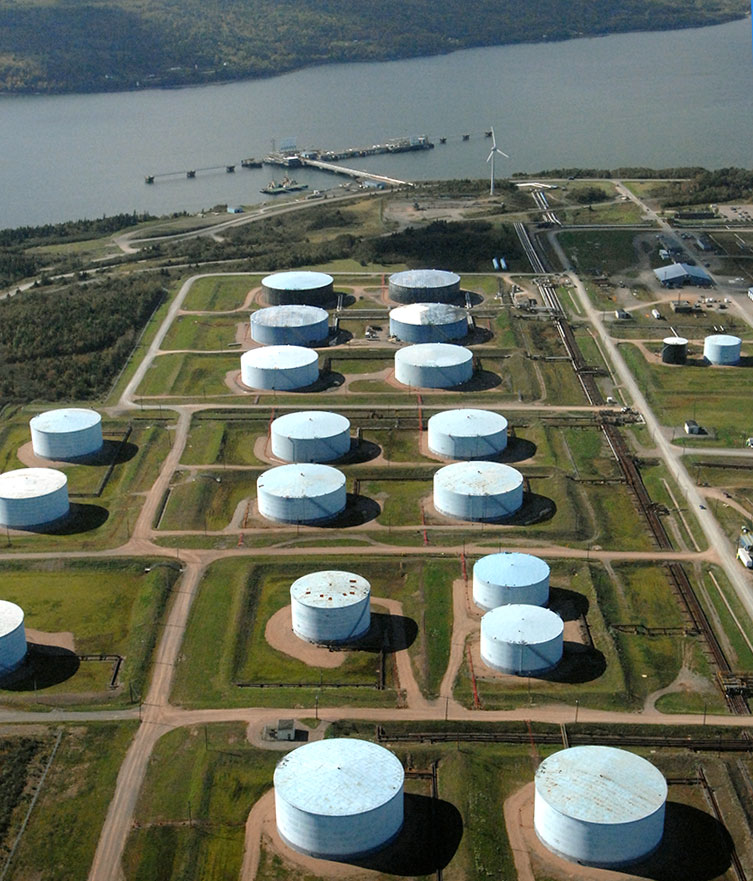
Strait Superport Corporation
To promote and accommodate marine operations in the Strait of Canso for the benefit of the area’s economy.
The Strait of Canso Superport Corporation owns and operates two marine facilities in the Strait of Canso: the Mulgrave Marine Terminal and the Port Hawkesbury Pier. The Strait Superport was formed in 1997 as a non-profit organization, governed by a volunteer Board of Directors that represents diverse interests in the Strait of Canso region.
The Strait Superport strives to globally promote the benefits of the Strait of Canso as the port of choice for moving product to and from North American markets. We continue to pursue new ways to expand our business and infrastructure that will in turn sustain our local marine industry and nearby communities.

The Strait of Canso is one of the best deep-water, ice-free ports on the east coast of North America. The Strait Superport is proud to be an advocate for the local marine services industry — and a catalyst for economic growth in the Strait area. Our partners and stakeholders share our vision of making the Strait Port second-to-none in the shipping and marine services space.
– Tim Gilfoy, CEO, Strait of Canso Superport Corporation
Canso Superport’s Objectives
Plan, develop and upgrade port infrastructure, facilities, equipment and technologies
Market, promote and identify opportunities for cargo and traffic for the Strait of Canso
Inform, communicate and advocate on behalf of stakeholders on issues affecting harbour management
Own and operate marine terminals, facilities, vessels, equipment, land and building
The Birth of the Strait Superport
In 1995, the Canadian Government announced the National Marine Policy, which outlined the federal government’s plan to modernize and rationalize Canada’s marine transportation system. That policy’s Port Divestiture Program allowed local interests to acquire public ports in their area. In 1996, the process began to transfer the ownership and operation of regional and local ports from Transport Canada to other federal departments, provincial/territorial governments, municipalities, and private entities. As a result, authority and responsibility for most of the ports across the nation were transferred to local organizations.
In 1996, Transport Canada signed a Letter of Intent with the Strait of Canso Superport Corporation to transfer harbour and port assets at the Strait of Canso. In 2000, the Mulgrave Marine Terminal and the Port Hawkesbury Government Wharf were transferred to the Strait Superport. The harbour bed management and regulatory control of shipping in the Strait of Canso remains Transport Canada’s responsibility.
In 2001, the Port Hawkesbury PIer underwent a $2.4 million wharf reconstruction and replacement upgrade. The following year approximately 300 metres of the Mulgrave Marine Terminal’s south berth or — 60% of the overall berthage space at the terminal — was reconstructed a cost of $4.2 million. Today, both marine facilities are fully functional and are used by a variety of vessels year round.
Board + Management
Tim Gilfoy
Chief Executive Officer, Strait of Canso Superport Corporation
Tim graduated from St. Francis Xavier University 1973 with an Engineering Diploma and continued his education at Nova Scotia Technical College where he obtained a Bachelor Degree in Civil Engineering in 1975. Tim’s professional career includes senior positions in both the public and private sectors. Advancing economic opportunities in the Strait of Canso region has always at the forefront of Tim’s interest and activities. Throughout the 1980’s he worked with the Strait of Canso Industrial Development Authority promoting the advantages of Strait of Canso as a place to establish and grow new business. During the 1990’s Tim continued his role in economic development as manager of the Enterprise Cape Breton Corporation office in Port Hawkesbury. The Strait of Canso Port has figured prominently in Tim’s efforts to grow and diversify the Strait Area economy.

In his current position, Tim managed the reconstruction and redevelopment of the Mulgrave Marine Terminal. As Chief Executive Officer with the Strait of Canso Superport Corporation, Tim maintains direct involvement in the day-to-day operational activities at both the Mulgrave Marine Terminal and Port Hawkesbury Pier, as well as promotional activities associated with the Corporation’s infrastructure and the overall Port.
Board of Directors
Directors are appointed to the Strait Superport Board, and they bring a deep understanding of marine issues in the Strait area. The members serve on a volunteer basis, and the Board is comprised of directors that show great leadership and dedication to their community. The Strait Superport takes an inclusive approach to Board membership. The groups represented on the Board include: shippers (3), ship service providers (2), municipalities bordering the Strait of Canso (5), provincial government (1), the Strait Area Chamber of Commerce (1), First Nations Communities (1) and (1) First Nations Communities to act in an Ex-Officio Capacity.
Joe Brennan, Chairman
Ship Service Providers
Iaian Langley, Vice Chairman
Shippers
Harold MacIsaac, Treasurer
Province of Nova Scotia
Chris MacDonald, Secretary
Municipality of the District of Guysborough
Richie Cotton, Past Chairman
Municipality of the County of Richmond
Lorne MacDonald
Town of Mulgrave
Evan MacDonald
Ship Service Providers
Jocelyn Stewart
Shippers
Bill Phillips
Shippers
Dean Hart
Strait Area Chamber of Commerce
Bruce Oliver
Municipality of the County of Inverness
Vacant
Town of Port Hawkesbury
Vacant
First Nations
Vacant
First Nations Ex-officio
Growth + Development
The Strait of Canso is one of the few ports in the world with the unique combination of a deep, ice-free channel and thousands of acres of unencumbered industrial land available for development. Sites like the provincially-owned Bear Head and Melford Industrial Reserve are well positioned for heavy, marine-based industries. In the Strait of Canso, urban expansion does not conflict with industrial growth in the port. Industries are welcomed at the port and the vast areas of industrial land allow investors to design and build state of the art facilities that maximize efficiencies.
To help fulfill the Strait Superport’s mission statement, a Master Development Plan was commissioned to guide the growth and development of the Strait of Canso Port into the future.
Master Development Plan:

The SCSCL (Strait Superport) Board and other surrounding municipalities see a need for regional leadership to help the port grow, attract new developer interests, provide a focused vision for the future development, and act as the regional marketing arm for the Strait of Canso. Since inception, SCSCL has operated in this capacity to promote the Strait of Canso’s public and private terminals for the benefit of the entire region.
– Superport Corporation Master Development Plan
The Strait Superport is working to play a greater role in the management and control of shipping fees in the Strait port. We aspire to create a level playing field with other essential ports in Canada and equip the Strait Superport with the resources to market this valuable asset to the world. The additional revenue stream from collecting harbour dues will be reinvested to promote the port and identify opportunities to stimulate economic growth in the Strait of Canso. Establishing a new governance structure will help achieve this goal.


